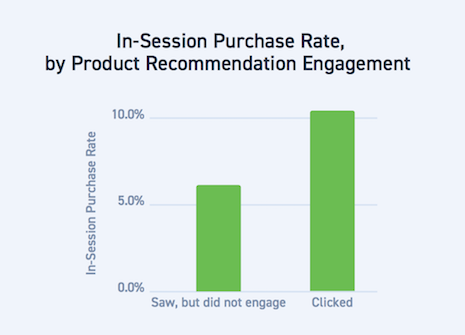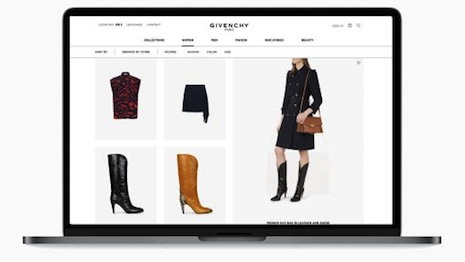Marketers and retailers need to be aware that product recommendations have a long-term impact on brand loyalty and customer lifetime value, beyond short-term conversions.
When customers engage with product recommendations, there is a 70 percent increase in purchase rates in initial and subsequent sessions, according to a new study by Monetate. Product recommendations are instrumental in keeping online shoppers engaged.
"When consumers engage with product recommendations — even just a click-through — the rate at which those consumers eventually move to purchase is almost 50 percent," said Brian O’Neill, CTO of Monetate, Philadelphia. "Consumers are engaging with recommendations at a rate of just over 11 percent."
For this study, Montate analyzed 700 million ecommerce sessions to understand how product recommendations are driving engagement and sales and improving customer experience.
Shopper engagement
Ideally, recommended products lead to customer engagement as shoppers click on items, add them to carts or buy them during their online session.
Customers who engage with recommendations have a purchase rate of 10.5 percent within a session, which is 70 percent higher than the purchase rate of 6.2 percent for customers who see recommendations but do not click on the product listings. In following sessions, engaged customers still have a 55 percent higher purchase rate than non-engaged shoppers.

Customers who engage with product recommendations are more likely to purchase items. Image credit: Monetate
Product recommendations do more than drive purchases, however. Recommended products also build customer loyalty by increasing shopper engagement over multiple online sessions.
Shoppers who clicked on a recommended product are 20 percent more likely to return for another session than customers who only viewed unrecommended products. Customers who viewed recommended products without purchasing were also 14 percent likelier to return to an ecommerce site than those customers who purchased items but did not engage with a recommended product.

Shoppers who engage with product recommendations spend more. Image credit: Bloomingdale's
The average order value (AOV) also sees a positive impact from product recommendations.
When a customer buys or adds a recommend product to their online cart, AOV jumps from from $107.12 to $142.44 for an increase of 33 percent more than customers who do not engage with recommendations. The average number of items purchased is also 4.5 compared to 3 items for shoppers who see but do not engage with product recommendations.
Personalized recommendations
For retailers to benefit from product recommendations, it is crucial to make relevant recommendations. To drive engagement, recommendations must be personalized.
"With the strong correlation between recommendation engagement and conversion rate, a higher level of sophistication in personalized recommendations translates directly to revenue," Monetate's Mr. O’Neill said.
Despite boosts such as increased loyalty, conversion rates and revenues, only 6 percent of marketers in a 2017 study by Monetate identified their personalization strategies as “advanced.” Implementing a sophisticated personalization plan can be challenging, but making an investment can have a great impact on profitability.
One of the biggest challenges companies face for personalization is going beyond segmentation towards customization on an individual level. Part of what makes this difficult is a lack of communication across channels, meaning that a single customer’s digital activity is not connected to their in-store behavior (see story).
Consumer identity is a highly advanced form of customer service, which means luxury brands will need to invest heavily in this field to stay on top of mass brands in creating above and beyond service.
However, the high number of brands who are interested in integrating this technology might not be able to do so within the near future. In a survey by the Association of National Advertisers, only 15 percent of companies said they can identify shoppers “accurately and consistently,” and 69 percent said they could only partially do so (see story).
"Getting product recommendations right for luxury brands is even more critical than for traditional brands," Mr. O’Neill said.
"Whereas commodity shoppers often return frequently and can be exposed to a wide range of products during their path to purchase, luxury shoppers often have longer delays between shopping experiences," he said. "This makes it essential for the brand to make every element of the customer experience as relevant as possible to that individual during the window of opportunity.
"By using highly personalized product recommendations, brands can build resonance with the customer that extends beyond the single product they are shopping for during that session, thus building a foundation for trust and loyalty that will compel them to return when they are ready to buy again."
{"ct":"0\/2qRcouKkhjkZNaZosT07HMfNKIbKbfpQzxIFOZsnBG88gBOAmTT2bflDT8O4G8aIYi9iiRcjxyIU54QkaxEzPQ1lXv41WdxoCZM7lI9d\/GI\/5A+aDakwIcqiuceujGk\/hJfO\/71BnidaQExBFrK5Xw2Zp8mNGT30DEcmzmdGFh9+EtY2dhZKCZ262zCVM6qf\/ARmEkHX8Ggcju2WXPLfYvBGhoY8Dcl9No53UMUYxLy\/OyxGw\/G6iXEOO4opjzLf4j8mY6OeuT6sTDJo\/h8IBHSouIF6tJ31vtLzG3j5yqz54TNje8qLW4Tk47HJqYj6xa0U3fRvyJUbnQtdBLo1AEdB5nN5Kd74LSJLWHST6mltYWV9241u4SsiZQKshmEVcSAKDo1RS\/h99OUEDuYfgEqhwI6YCz8TYcxeEjZMh659v7MNDlgxjr2jlWiQDgsi9e3QLi7I5IOWF\/ya45TlD0mXsxkH2QngmjHGqljD5AEtqdv3rgvIDNXgjbm\/4to2HzP2OLHuUW8RBEYrtfgiAdq4OlUiy2nmEcu0XfT8PyKzVk+qUaCjsvunu5BKhXd3iNQkpjwuTt986rh8boC4kS35PZ18nesBnTHHg7J9ST\/9sMfoTh3L6Ey5Lx7J0duLu5+cWuYuykuaJFSwOC0LV\/8ZTDa1A93thbyCLfA3R8uhPigdAOwD6\/MG7jdd4hdmFSg7BmEkMRidM\/IMWt463LLfCCfPAqGLNX7HkNbkXqYdjHAZA8WDed\/vJdMEV3AmrwgA7OAZwOhW0hDLOEYFBvWFwQE50xWoB5DGWxRK7rb+R6hpl4rDPdnMLlS6Jk07ZEVHeSJ3ItbZUH+tYrgUxABwG0AOq6jKwHq826ke9jj8yhw02Z8Ruxm3OypboRCKI5LAhVw8LOAKpbpNHsZd6gwmXE\/s+I8U+4iDYNvGTcO9KJfRZzPmx0RvkCyX81TfZ\/mkTv53M+Z5BRboCq0hvRUVTTwHXBbQ32Za2igfaj86R8f5yxQ\/6cD\/q\/6vQHq7zTjjoLJmux59A4GQ07tPgGj8PFcs9EFIqK5r3GuXF83p5dxp8vUQsSTfj5VNGqNx0GxEAcnSyfaURCkSWzP6wUpBQuczAgu6HKgLMdvwlETO7w3uWsAUtX39TW1gZy9yyyIRe\/QL52S6VP9xBHcCbWRAsurU4fqFU9+D75HKjI9m\/rHRqK35KLbUZ\/+vfLpIxHsPRu1ammXSWdpzbD+R4yKHOZXFVT2dsx7Q2iZDfQQe8s4iSkl9O7TFFWP4v331hKDia1pMO3XqcetscwtiIp\/ErUH4McgAbuZeQkUV6uaLToIOfSKRTDsXatXUNVCjy7iIsMNd9bDtRZenj0uzr1BAlSdGGgLLi2LP69FWhlxEXLaHWWnJm2q2OOPBuU0N4ecx5JN3mM+Jd1ZrRbdZnVttBaSKHouHSOBG+xRXx72x95x+wHJ4+WSrXG119y71Rxlm26w8WhY3P2CC8l6OTKsWDggGXbx+dBOG6\/72VXd44NHLa1pBF\/6bK4ZGAJf5ICJivKD+EW7dXP4vp3ZesyY62EMJ7gxbKmxnf14FRXccHWIQ2DVVMWJgkgH7xYVXcNOrjDN+jsa3YwUigdLKAVHPCZXQMOKI8hkPNdbNuHJLvYATwWFOCdGZuU13UuVaOORDtVH0mRRKYvkh1vpN16RyQ969PlD71VcgGqMNxYlbCqLjzOZ20a8wqXk6fKlnIHLsYhQ3S4fmX9g7mPAUtL3BC+9ejK9\/ThsX+VYkEFthQUZj\/EEQlCz17r0QImi9Dvk\/kHP95dmqdGmb7y4HrtWzQK2QzSnwaua1vRI+Z2pUKv9KNIC7ItzgGfCbXZpOqILCoduPBiSCov8MgEzmXaJbnMsGxIKPSsUy+fNbahdQ0ChgCW3TMu4P7z53O0cREVbeXA0TyOgitRC6NJe5HhQYPbP3UEz3gLCjIhJ4x\/Cd+Z86GpBhMtz9Y1\/krIKpUJqGYUEjU1atX2lggeFlWfJcQ029qkwWIYyjx0\/1B1RC2LdZP6noDtVpkaNJelqgbxD+mBmQQaVb6vGZfOFtSOjnMRJ2wup4JOeAe77ukFJDKYMNm2LB6GwOSzb3H84DAjdQNMqlPQW34vuWCM25JpB55UY53+Uo5a3SmD6pCed2PeXYnDEZdA3xjEtg46TrzT78NzwwMUoXkf5NoB4Bye00AU57blQsWcJ8aiq5qQVgYEbO\/tK+8WcOGu2O0W71daOrGTXeqmImVXIX\/SrZqC0bUFyeL3skTFw4oAd8UUzICG6jtmPXNCeCJU55ul5J+yPDEXutfGcVqsUpY7D5f69CjXucajFHCEGkiuZyWu9RHAN8AAowyBtEM90Rs+0SwYsAfNqxVAz6gKaJUUmUvA1yjTH40aOtBITrEszzG7mVc4WC4\/6sbUNT5lXL0rZYBdyNffccRuXCo5H4JSp6PoPbEsTLjHR+MjJKVIjm71QifdfJqX1zIQhXfTj8DpzzF72Qn48h5Q6cPaQ16049Z4CDX\/\/xczCUJW7Dcy0cya3gu32kcBpSXfDVdBe\/vwZDLZMy\/baz4lbE+BNCIJ9G1AuEHZmdQdJIPP3Pz\/y95mG9UOsSE5JYLUxgGYi\/PCcURJA23FyOl11eLr1TYuv3iGbKoruScEl+Up+7pFxWhIkLUaT79rlcGRJShrv68qckLLinZozhRYvDk0hkvQ+Ci7zh9MKWPqqoUF6peq+v6Ia9BZOHroBLGj6tmE\/Ywg284W0CAW2Ak\/cTFnSFY0Hf0P\/whdakkugjmMcLKqzrVC6xhBES2fIX7cOhcYPWdMVv53\/RbasHjpp+8Bq1OH9+sE1rmwp6bVgRMer6M0gFuRNyso1ZQzrII4Bx2hcRyCd4N4+ey0hMtsUpiG+fc3kmClfL62XbfCxNvVDwH\/uCGDPaWTRwGbwF7+u2TCYtH9+FYmsxSEKKuHay0Ilc\/t9GIYB3o6jp1b87umP0zoqEo6Mv2V4BQnhwlOnVHwmv+gUOsMTGYo3foO4LNRf6du4jsosv1khN2Oreos286nVgF+PRLQY7g36g+etBBeT8NIbC2WVcHjdXByxNrIh64aKRS47aZgAraxz\/DZiwvAuMHOrLOtm29Uv1eh9qNtKDWGpbLiw\/jGVnahhr1BVmiWZikZj5eGHerUqD1mRdgml\/omwZSCcbg8L8Qmff4u\/GpeRSM670iDva3UVyXuQcDTr1ZS4X2f9qGs0OBEG6lvyqHOaE+cwPF\/hOEwZLClEE16rpizlXpI9swfn2JPok86bZZ4dTaQYtFwLU200L8pOSU3Jb1bwlAnVFetofgSVxQC+0K\/UIhz2g9mwSAdm1KmI6nSeCiR0bNlMxbrkurWD2zmVnPjM98ttOREdhK+G0KDrQMLKnwtASRL3imIBFoywE\/wC6VWDbidVHFgY543krmrulVdZc\/MRvMQeJ2XFVTjM6J8y7+bs0ATw1bSjmtikrZq3VaAukO1AzO4LKmFpjkHvvaILS\/m1DxPm6ompMSAY9FeKZrTLckMfmSotok0zvLf1QTn74VLHuyhcA6KcOb\/H3sQ64\/8jCRICXLbhtNHh026hY6IMO+mKi16PXu6hX0UcKPb4fX1rDLIBwKrNlz0B9\/uiZiwkiFGGZnNWkvKhbK9AZSUoxWTpWvnssrRB5saQIGswKKRh1yoxZHCbmvxalOOhJN1zcoTyKACFFdnySZpMf92SsHCnDwf5rdGPkiqj7XVMkPH101fBoNzZpiY6iPEbVzqmjh\/QjIs\/zxI15NaTX5zrqkQS957lCweJ4JOEvZ9iVTCuuZusROSpxulbbkgnylgfbAvsOZANF1qr+VSGmcpyV02T4tkAhYXLoLOy6MK9+b7gPm6qz218uLpBVU+Lu+sC+5f8hu681gtk2FWmaikvAaELQKgEGoSGpgf+0aJHV9ALUs8BoD6xvMzHHG1aXS7h+zE4JMjtyZN8y1sItc6NO0dImzAoExKFjKjxgufeTFMuRMaVh82Py699VzyWddaPCfoJKGiw+BwlYDxKPwJ3p+FMcMXoSqprP0H5o5D18aNgPix7PSe2H+3IqcnyF8iTUc7dH7oIkLAJpaHYJszmM1ZQauZSzf4nJZa\/UKBPxtt7FVoL5L5Ow9xANLS+RocHt95han+0bGaK7OUXzSVaeBoqBSPuNtoP84GRkLhAdJIpoMFePoHxC0PF6OZN29dspSDUiG7cjy+Dk4qqHCJhhaIgozgS1wwsQ1bBY845jGbFDNAjIZgczIY4ffZlaWuXezCdkC+ALMjSY0SfMfnAeYDECC91n+eX+LopM8MDY4TtkWWRYkE+AM\/pxOUWILcsKg8czRoe9ayi3EUbYDWCx5S74wgYjTjoSeEP3xzaGViFTzGJUeTJ1PHYzYbdiWeK32xJbDUhbiSgLMGYXDAKiwHW9\/3JNSjpN7y8BIs4pe9CaSideGSNgf1Gs7ZwNn3mhYaUFtdHGlvg3XV59T0fWi+81M9MbHeXKkPUkijmmCHgrpWg+j8X0sgCeCrmi3IPeOQqAcz7+jqZUdPvnoPhGlCQeFR689zOd+1ESGZFYOzdEb7a8vC+V8h1jFiec7uXcjMNBwRkHdOr3vHBhZiqOffzrJ5rc9sSIpqCZlC\/9BNucAs\/He91aRLySHbcGFtg7MKJGq7HILZHLj9BGzSqOC1r7vTkupN6mlTWbSwCOdZDC4oTAvOTHE9fuEsIsNb+yjkrDDJiXZzGthYvTU5teCrdDfbvmrchdfYQQ1pH87ZBKMDTT3nJA8rnDlT2ogmcB99BsbgsSqy4do0T7h+P9atiyTyXl2JKvjEv6SsJ3vRbn1+4ho+C0IibU0foCjvj0dSFavjohPSu21cvxou5Raf9Va8Ei6uPfjlmE1zF96mHIusxYa78ktgk\/ayCZ+1jjUScnzlle\/aNKbDg0kphV7bL9GDzaPHfygy8ieX144dgcQCFZjBBhajMjQteZSf+g+TNG42FQukHU6x+LX6xRD64WV3qMApCqZ9Zje9FINvs00LRJgAr5\/xwPWwiVDDxSgMJNUQDfWwH0OtDMCm5juKJ2A\/p1UXKJcf29VUI5n4jW7hKG8YXwzAtocF+XfvAUHVihDwdwq1P36EIKxUw4pTgbTpIrhZ9zNYCIKdbPTQNoR8WfzXnin52bQMFpORGmxdVHGdMolJbvfxynZ\/MqvTNjzrYZSYZq8E8m\/Rr0Lkc\/fuQMlqOcqx3Nsh0qfRmkR\/CqAOrbunE6uSr72GFTlWleSi3DKqQq\/9noVDW9qVVYvIUKDR56oDoQ36VJ1d0U97xxFSHSxPaC9cyvbpJYiF1pwbdwC+hjht6p16U1Oel+BiEYb7oqFBRsi8pqimNtr\/d+K1HuXejvVQjNPER\/36aa1rgeDm\/W3X5lgTaCckX9hOp5HaEhfqu8Ux+Zz+JYACrtMOHZhIYJxW3TGwKibEbJFkBtgS13YCdsK8Rjtc1Oj5WshspapryU3xluu+SX0sRXLKN5eHvE7emT2DdU62G3h92k9w9kiDhQAiCDJSPELCgoGoQB93ltQGHf8f5lMdXER+CsrmLiVAgNZ8U5bmLiyet2pOy7\/eDhU0I4BFP4\/JLosDbtDAYS2CzE79C3Yj7EOyEJ3cuM5WwTjJGIGZg5wA6lkVLUtsI0xrV7NsfAVvZNJUUFIKWa0rLzfoGY\/z7fCh2n\/rCKh4d8WGN9ExetaKv0D5bJTkz6ifV7lfuxFVaLP6eBwJF\/NYG+47Sx69VBki9UzDxc9mNq6Sg+2nSuxiIncwSVHCvIOFhkWFfcuVc0Y+NCvU5VthukGsZlkccijEjSoQr2oBx35Gfq47KxPsHCv7oUTqfUYRcKRZPv5JZkbH2Tx6jbf15\/i2xEsnVrLpn+rSUqph5GEXEGLeFKjtw1\/+1gPSTFhTU7unjYRPAboAHyZgKVdPyYDblPFV3aXCZJOg\/CAdl5IR81DHqPqUhpNp2D7IskZnzftccWW+zXqxGaXx5CJsSKVkWuDaypqr2VMhPz0QcecaQ7Mi7ct8Z9rvPIVqjLnRN+laOd1zCb0qfhd7pFZxY8mw4kc7C2Sdr859IcqW6vXPjF+Lqj+nnCf0WxxZMmih8HYoqL\/EeVLhsILG9+Zmo26u9t4vEX5nuZ8GVJV1397bTJmRKmMUH1Y91f3MMU9j2idjHVy8FdCIRwqA9omuNUS\/Z0WGRAkSyQ+OwJ5O8ysrYIVbQsAQ7lxmjlzYCzYgCruyFCgRdEWJzh1OqxbIKbYEzzg6sKFoY6yTTGlJqjtupIifQUmYFKjJHFld9NY7Q1Zoyjkf2sM6qJXxXaZl58\/TVy1ZX47zfBEOi4FRjVDywS8o922dfCK8+zhqJQGGquaB+q1KxK0qknXaZoxlkNj3\/Q2GgdWj5V3m\/AqGOtvcj2GaEsv7DuXEK9NnJVcBZUzDQyyZqgKmdTGy2Pam4li\/75Ehp42yWOEY9Oi\/AGq8Ajsmpzv5PFwi6GVP5eSZUpa+w1SwvdXVe7KxcY3J68BPjeIOZqAGmcqw9QPhL2H33VLNNe\/TrDH0GdfojxfktE7I99nddqqsYrIrbPLEz+M06lhuPHYw8LbHJmQv1582IQw3GBxlQQpmSln5ycYIfg9cZXDOeQea2tN0ES86AN3cbCqgpOV25ipIop+MIrTZaqo\/fIOkPae2XaFZqPcY5HBORxbkKtg3LOstrP2PsyDM00elVVHfsEY6LO4aGYjpTEA\/a0wDZPGOhJ8\/v6En99fpbhyFelWv8GhYLoHh9Qc\/5qLGJAqRgUv3zFqY0bH4ijY8xJeIsylpFgnQ1uf\/vTtEfXX3gxxhPUAKzGH5mmZ9OlEoKpXR+fxkQuC59qvaAY8BDgfG2iNzsBfjU8Jn+F8UbtLnzKK4vaZ0tDonfprOTuOjYrBHf42W2EPdPqDFrvufHU9PD2vrrFLXOPDEG1\/3s2n5EYOEMyfAGVGjuZombwouuLBNUn1Dp7KnCbwJyE5XTyFxwhr7Dhb8lZgI0tkSQtne5ktUIZlnA8Jau3s1pKU6FaAFxmh1ITnu8VbbG3FeKWCjzTUavPG28K9PA6YzxjqYxvkZIvm08EwZrmNLs30mc\/sLGI1ATeLjdbZng9Xw92xUdrOh7rTPugZ6Oq\/S0alBvr3ILyg13Cvj5H1s9yQgMr5SadLGF9pm+ee01qFhS2ZqkCube07McIR9WqFavhlcEcRo2LBbximV\/aqCja9s+CpZHkjpgaDdEF2hMJRqmKRXa1QiCaJrfvqRuZagF831jE\/EC8twFa0UdtcIv1CVuYZKuxHSnC5Wvsgmr9v9czhhtdZ2muiPpeWTPGRBTnAsTiL\/u\/29AqcJA5NGC\/uyYDgah8dRbIxk5zgMqIyo+dNGhugqCrH3\/ezgGDDT37MOm6GwNXvsMnYyiVRR0z4MK5nwf9bKz\/\/iSrQuMs1TpzmZxHVY9sFfvSfSLjv39C44t+qh720A8sLnl1C3R0ryJoAuliZLi4NmrBDTq5BCvZsv3Nax8kqj9lYW\/SlLLXP3H4Jk\/V1ksFo+q1hefc0DZDZbuJrSbttwYzF1S23mUT4n+P5EsN5iWeaMVXv5vUwjXqxsAyttLbtkpdfgWcWaVhSVXhHcwucc4YJxNcJGqezh6YWRDT5LMuxWQvjxypYWU4dajZRGNeoMgL0B79Z61hyCZiuphXuii\/9zmCWH6up\/hEbLDERdEVG6pI9Pu7sZS\/rxKAsPs\/wpiTbnQ6JVexqEdoCYNy3sWO9Au1d2i2E3gTGullFUvQhdfYnytAAT7F9thsiWhw3bLLzCTgqlTDV1pISw4FM5l0A7C1D+GN291K2Cq\/1KwpYlAs6umX4I30mUQf58nL+FcQ\/BH0BetD0LwA2Gf03+qKYG2ZmdNym+ddbema\/GQUltbJskz5IigE\/sE0td5GOsDZVUXWZMYjaTOUxTok1hOEZNJ0awb8IsiNgwzKKRF4OBe3JMyW\/X2+jaLHKHTXKQ5bHHXR2R1rjePBN07wdGhCL1sDbtYXv9F8Og7WSeti8V8\/MFY1gDluDFkLUL3BHda0Q2yTPQMLQ+vR3GFmYecNoiAb5zfjt8DYu8lKNB4BA7yQjG\/ZyhpgR2o2wC4gj+BZPTd4jcfJbnl7ZIWZymu9p3RN2vSJ0NpGhpFicnroSbuygRm2FO0nLk\/lp8mqspbTiVKyZjESuRzlKl6hLZlAMG326yjA4zOcv0p3UfKeTbKwbV\/dQBxe2sJ5efieRTfhkaL0rLBgoanheLjFgJB7qerVMOQVeiih0qga\/B5vGWNSbb6koXAE69DHffAAkIa2bZU7kZqpTECQt6gKJyr3q8895Veyt7OujacnhNwcKIKoqIaHBoYSBCciRvBCBAxRSdvFYv3Yr9riFUoi3IFipb9bR\/BwugNNwB8aYr15LW5snfdg63bfKfkpb0oT\/Blyyl+jKdQG3MfdGF8RmRfPd16qg74Hk0ENNGuISymdjs9pWltV8agMMCXEgb5Kzqan1pzKc+jCWeOB8X2mVFVuUjowyqz\/FmKbXk0LBfXWluX1YdxH1iUU4tuP2dyOLURsigMv1pccNNWQkotQPPnaIWyiSK1AtWTE8MStLcwN5dLMiu6RulAfQxjYpHio9sdIQyEHsiiUb5uYJNU24rCBxvp4Cq14k\/CJsSoaOmmph4\/VwZgnmvD2r9tRVC2TcfP6ToUqoLZLyb2LS7oIelPPyGbT5aeNtOzaVKjA==","iv":"08a928ae2071a32698b523b6c0d5f6e4","s":"3479aac0b573a40f"}

 Even heritage brands such as Givenchy have now embraced online presences. Image credit: Givenchy
Even heritage brands such as Givenchy have now embraced online presences. Image credit: Givenchy